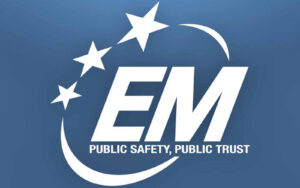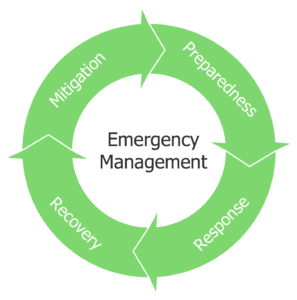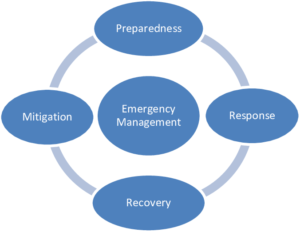Back to: Religion and National Value JSS2
Welcome to class!
In today’s class, we’re going to be talking about emergency management. I trust you will enjoy the class!
Emergency Management

Emergency Management is the organization and management of resources and responsibilities for dealing with all aspects of emergencies. An emergency is any unexpected situation that poses a risk to health, life, property, or the environment.
Key Concepts of Emergency Management

- Preparedness: Taking steps before an emergency to ensure an effective response.
- Response: The immediate actions taken to save lives and prevent further property damage in an emergency.
- Recovery: Actions taken to return to a normal or an even safer situation following an emergency.
- Mitigation: Efforts to reduce the harmful effects of an emergency.
Types of Emergencies
– Natural Disasters: Such as floods, earthquakes, and hurricanes.
– Man-Made Disasters: Including fires, industrial accidents, and acts of terrorism.
The Role of Emergency Management

Emergency management involves creating plans to reduce the risk of emergencies and to respond effectively if they occur. This includes:
– Evacuation Plans: Safe routes and locations for people to go during an emergency.
– First Aid: Basic medical treatment provided immediately to victims.
– Search and Rescue Operations: Finding and helping people who are in danger.
Examples of Emergency Situations
– School Fire: Evacuation drills and fire safety education can save lives.
– Floods: Building barriers and having an emergency kit ready can mitigate damage.
– Earthquakes: Drop, cover, and hold on drills can prepare students for tremors.
Emergency Management Agencies
– National Emergency Management Agency (NEMA): In Nigeria, NEMA coordinates responses to disasters.
– Red Cross: Provides humanitarian aid during emergencies.
– Fire Service: Responds to fire outbreaks and educates the public on fire prevention.
Preventive Measures
- Education: Teaching students about potential emergencies and how to respond.
- Drills: Regular practice of evacuation and safety procedures.
- Community Engagement: Involving everyone in safety planning and response efforts.
We have come to the end of today’s class. I hope you enjoyed the class!
In the next class, we shall be discussing about the Social Environment.
In case you require further assistance or have any questions, feel free to ask in the comment section below, and trust us to respond as soon as possible. Cheers!
